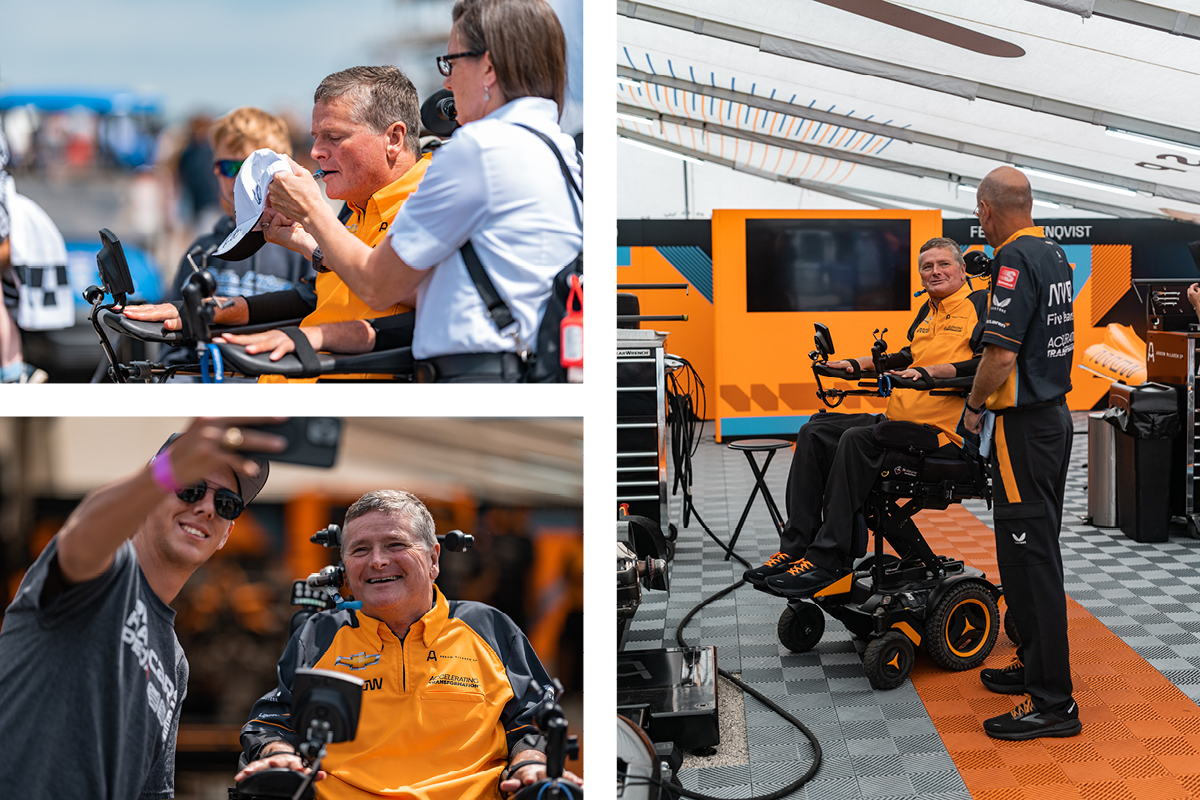His physical condition hasn’t impeded his personality. He greets partners, friends, and fans with expressive eyebrows and an infectious smile. Fans line up for autographs, and he obliges: his assistant puts a marker in his mouth and he moves his head to sign. And it’s clear he’s revered in his garage, too, as the team jumps at an opportunity to chat with him.
So much of this is just because of the lifestyle of racing—something that’s called to Sam since he was young. Even though he can’t be behind the wheel any longer, the atmosphere isn’t something you can just go without.
“The lifestyle of racing was…I was on the road 150 days a year. That’s what my and my wife’s relationship was built on. So six months in, my wife says, ‘you need to find something to do.’” As a result, they founded Sam Schmidt motorsports and raced in the Indy Lights league, a class below INDYCAR. It gave Sam the outlet he needed. Over time, he partnered with Ric Peterson and the team moved up to INDYCAR. Later, they formed a partnership with Arrow McLaren F1—and Arrow McLaren SP was born.
Red Flags
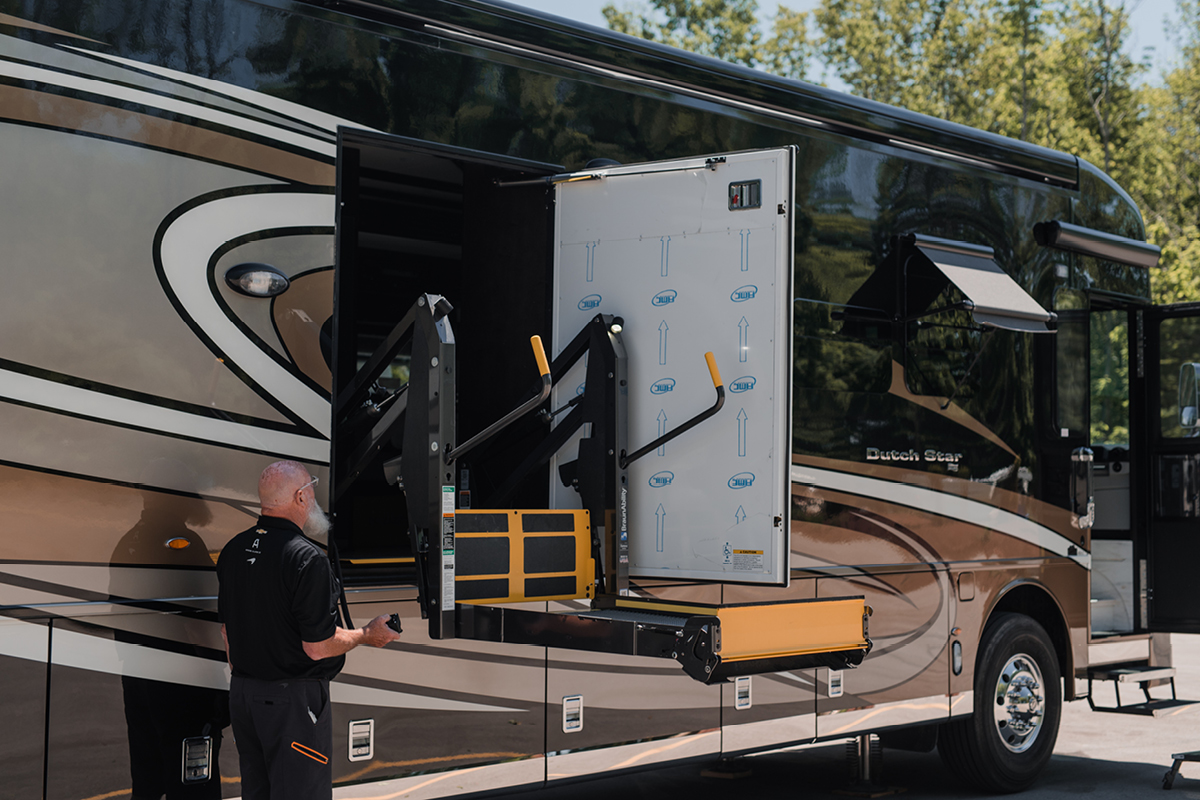
Despite getting the fulfillment he needed from owning a racing team, things weren’t smooth for Sam. When the team was founded, he would fly into a city, find a rental van, and show up at the hotel. Despite preparation and calls ahead, ADA-accessible rooms with a roll-in shower weren’t available. And he’d have to go find one, often at nine or 10 o’clock at night.
It simply wasn’t sustainable. But out of this need arose a solution. Because it’s so practical, many drivers and team owners will stay in RVs on a race site. Sam saw no reason why that wouldn’t work for him, too, though clearly he couldn’t have a conventional motorhome. He contacted a different manufacturer first to discuss the possibility of building a motorhome that worked for someone with his unique needs.
He says about this other manufacturer: “It was a disaster. Everything had to be built offline, customized…that made things more expensive…and there’s also a concern in the disabled industry about cost, right? The population generally doesn’t have a ton of money.” Around 2006, he contacted Newmar. Knowing their reputation for quality coaches and for doing what they say they’re going to do, he approached them about finding a solution—designing a wheelchair and ADA-accessible model that could be built on the assembly line, so everything wasn’t custom (and thereby more expensive).
Green Light

Sam eventually traveled to Nappanee to meet with the Newmar team, and toured the assembly line. At the end of the tour, they had a prototype ready for him to check out. As it turns out, Newmar had begun developing a mobility model before, as the child of one of their engineers was in a wheelchair. To develop the coach, they had a designer sit in a wheelchair and roll around.
“Honestly? They got about 80% of the way there. But there’s nothing like living in a wheelchair.” Sam wheeled around and mentioned a handful of things to adjust: lower switches, lower countertops for line of vision, and one thing in particular: more space around the bed. As Sam says, some people who use wheelchairs may need assistance getting in and out of bed. Extra space around the bed allows a caregiver to better maneuver.
Newmar’s first mobility unit was a 36-foot Canyon Star, which was then a gas coach. When dealers were able to inventory them, they didn’t last very long on the lots. Then came the Ventana and the Dutch Star. There have been as many as five mobility units in Newmar’s lineup at a time. Currently, the Bay Star, Dutch Star, and Kountry Star all feature mobility units.
These days, Sam takes possession of a new coach every couple of years. This year, he’s in an all-new 2023 Dutch Star. “It’s 43 feet and has just about all the bells and whistles,” Sam says, smiling. And he’s as dedicated to Newmar as Newmar is to him—and all disabled people who want to travel.
“We started a project together for me to go to work. But at the end of the day, it’s helped so many people get over their mental frustration—their locked-in approach—and get out there and enjoy life.”
Sam’s an advocate for life after disability. He created a foundation called Conquer Paralysis Now, whose goal is to find a cure for paralysis. Beyond that, he wants to show others who are confined to wheelchairs that the world is still open to them—that they can still go and do and see.
He says, “There’s a large population out there that just doesn’t know they can get back to life, life with family, just getting out of the house. There are 17 veterans a day committing suicide. And a lot of this is because they think life is over and they can’t carry on.” As part of his foundation, Sam hosts an event called Day at the Races. They invite people with disabilities and neurological issues to come to tracks and watch the race. Sam and company have hosted hundreds of people. They pull out the awnings, bring sandwiches and cold drinks, and show people the accessibility of the track.
“Beyond that, I’ll tour them through the coach and show them that, ‘Hey, this is a real possibility for you to add this to your life.’ Someone told me he hadn’t been out of his house in two years before this event. It’s just an unintended benefit of doing this.”
Business First, with Fun in a Close Second
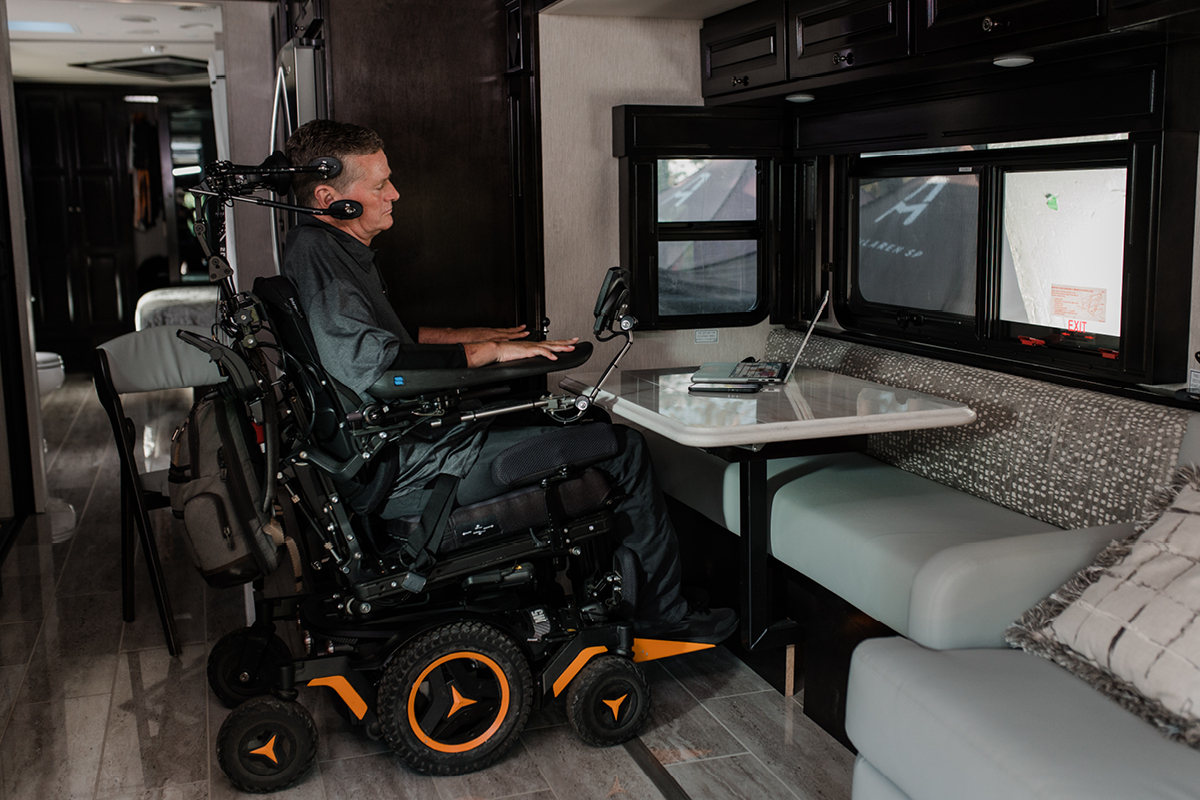
The morning that practices are due to begin, Ric Peterson steps out of Sam’s coach. Ric is Sam’s business partner, and the “P” in Arrow McLaren SP. He smiles and nods, says “good morning,” and goes back to his coach, parked next to Sam’s Dutch Star.
Just like any travel in an RV, where the coach acts as more of a basecamp that allows you to venture out and do other things, it’s more than just a place to sleep for Sam, too. “The coach, it’s where you can gather with partners that isn’t in public. I’ve had really intense, important business meetings inside the coach. I’ve had negotiations that I just couldn’t have anywhere else.” He calls it an office—and a home—on wheels. Sam will take calls from the dining room table, or just use it as a respite to cool down when the heat of the midwestern sun gets to be too much.
But more than that, Sam acknowledges that these race weekends are an opportunity to have fun, too. While the goal is always to win or place high, the pomp and circumstance that follows every one of these races is celebratory no matter the outcome. “We like to have a good time. We’ll grill outside, just like anybody in a motorhome. We’ll let loose.”
And it isn’t just the team that’s doing the letting loose. “I’ve got friends in the area, they’re coming out this afternoon,” he says. “Most anywhere I go, I’ve got local friends and—I can’t just hop on a plane to go see my buddies for a weekend, right?” The Dutch Star lets them gather.
Point A to Point B

Sam acknowledges that his situation is a little unique. Most people buying Newmar mobility units likely won’t be using them to run an INDYCAR team. The team is based out of Indianapolis, which is where his assistant lives as well. Sam, meanwhile, lives in Las Vegas. The team employee drives his coach to the race location, gets it set up and ready, and his assistant drives the mobility accessible van up from Indianapolis. “I’m able to fly with a backpack,” Sam says. “If I didn’t have this coach, I might have to spend 40 minutes a day traveling to and from a hotel room.”
There are a handful of races that occur back-to-back in the Midwest. For those, Sam will sometimes just ride in the coach. “I’ll bring my family in and we’ll just enjoy a little more time together.”
Constant Improvement
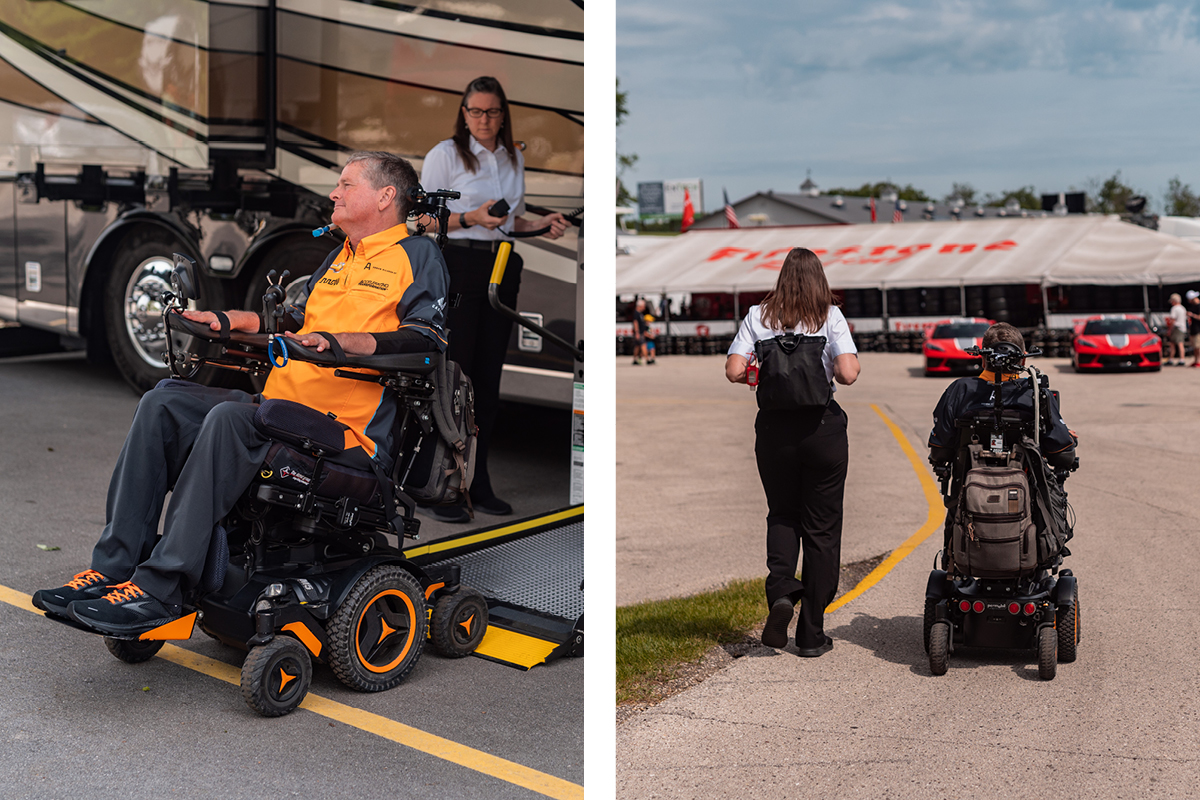
Over time, Sam’s relationship with Newmar has only gotten stronger—just like the mobility lineup itself. With feedback from Sam and continual improvements from the Newmar engineering team, mobility floorplans have continued to evolve. Just like with technological advancements, other components have improved as well.
“At the end of every season, my assistant and I sit down and write four or five things we’ve noticed that could be improved or changed and send them to Newmar,” Sam says. At no point, he says, have they waffled on if or how they might incorporate them. “It was never, ‘Oh no, we’re not going to do that.’ It was always, ‘Oh yeah, we can work that right in,’ and just do it automatically.”
Sam notes that every single step forward has only allowed people to have more independence. And if it’s not clear at this point, independence is something Sam takes very seriously. As easy as it might be for him to ride down to the team’s garage in his van, he rolls down in his chair.
One feature he particularly loves about his Newmar coach is the fuse panel in the back. “I’ve got a panel in the back where you can see all the fuses. Having a mechanical background, if a light goes out or something like that, I can diagnose it—or even fix it myself—which would be impossible in any other coach.”
The Outdoors for Everyone
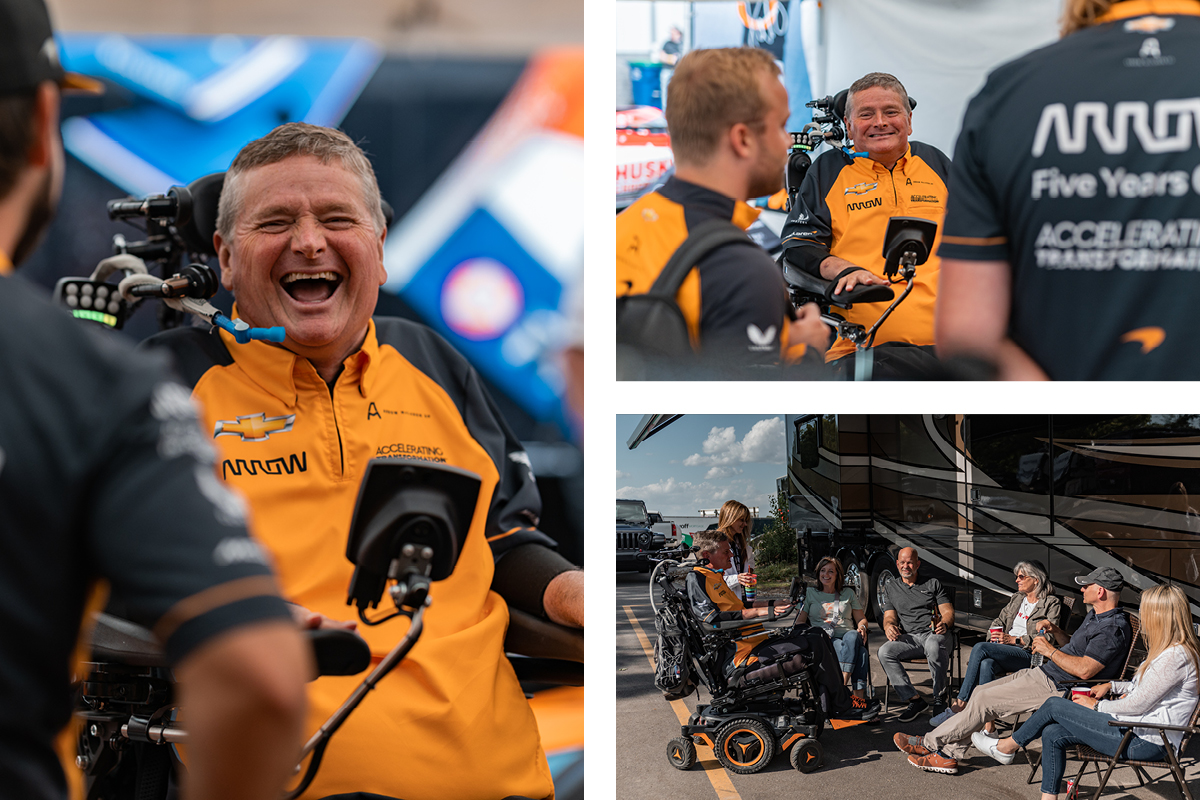
The energy that flows through the team is electric after their two drivers qualify. They’re both having good seasons as it stands, but working with the engineers in the garage and watching them tackle a complicated road course, takes the excitement up a level. Back at the coach, Sam’s friends have arrived and they’re all ready to enjoy a local beer or two outside. Sam smiles his uncanny smile as they laugh and joke. As he says, “I do this to win races. To win the Indy 500, win championships. But we all want to have a good time.”
Later, he reminisces about his life in racing. “I never really thought about it much in detail, but I probably wouldn’t be doing this long—20 years in the business, traveling 140 days a year—if I didn’t have this type of opportunity to simplify the whole logistics of it.”
And for so many, that’s a big part of what this is about: simplifying the logistics of it. While others may not own an INDYCAR team, they might enjoy watching these races and parking with the thousands of other campers. They might simply want to visit national parks to see the astounding beauty you can find in our nation. Or they may want to just get out of their home, because for the first time in a long time, they believe they can.
“This has given so many people an opportunity to get to the outdoors—go hunting, go fishing, do different things. So, yeah. It’s been extremely fulfilling.”
